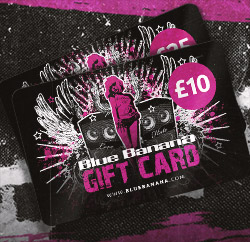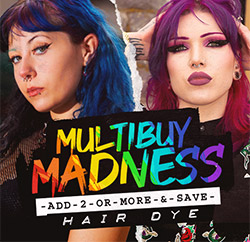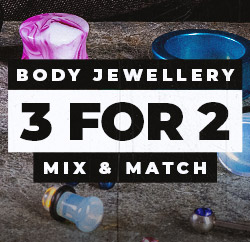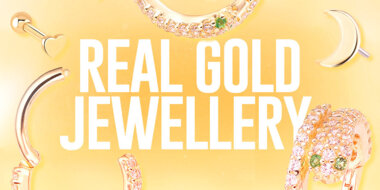1. Ear Lobes
Ear lobe piercings are one of the most popular piercings and is one of few that can be done legally under 16. In fact, ear lobe piercings can be performed from the age of five with parental consent. Not only is this piercing widely fashionable but because of the fleshy nature of the area, they are also considered the least painful. Many people describe lobe piercing as a minor sting that lasts a couple of seconds and is less painful than a bee-sting.
In terms of healing, lobe piercings are relatively easy to care for with minimal soreness, all you need to do is make sure you clean your piercing using salt water and cotton buds (with clean and dry hands). Your ear lobe piercing should be healed enough to change your jewellery in 6 weeks and there is a huge variety of earrings to choose from! This piercing is perfect for piercing virgins and looks great no matter what your style is.
2. Navel
Navel piercings seem to be evergreen in the world of fashion and with such a huge variety of bars and jewellery available it’s a great way to accessorise your look.
In terms of pain, the navel piercing isn’t considered to be one of the most painful, with most customers reporting the actual piercing being similar to a bee sting and experiencing some discomfort and soreness in the area whilst healing.
There is more of an emphasis on the healing process with a navel piercing because it is kept covered and could be caught on the material of clothes. It is important to follow the cleaning regimen described to you by your piercer which will usually be cleaning using saltwater at least twice a day. To keep your piercing protected, you should wear loose clothing and if you’re swimming or exercising consider using an eye patch to keep it covered.
The most important things to remember when healing a navel piercing are:
- Do not change your jewellery until the piercing is fully healed, which usually takes up to 6 months
-
Avoid all stomach exercises like ab crunches because this can cause trauma to the piercing
3. Lip
Lip piercings are increasingly popular both in the alternative and mainstream fashion scenes. These are considered to be a fairly painless procedure which consists of marking the placement with a pen, using a small metal clamp to hold the lip secure and using a needle to pierce through, before inserting a labret stud.
This piercing can cause swelling and soreness (so you might look like you’ve done a round in the boxing ring!) but will usually heal fairly quickly and should stop being sore within a fortnight, however it can take 6-8 weeks for the piercing to heal enough to change the bar- so be patient!
The great thing about lip piercings is that there are many different styles you can have:
- Snake Bites: Two piercings are made on either side of the lower lip, to resemble snake fangs. This piercing can be worn with labret bars, or a ring piercing can be worn around the lip Spider Bites: **Sometimes known as a ‘double lip piercing’, spider bites can be done on the lower or upper lip. This piercing is also worn with either a labret bar or a ring piercing jewellery.
- Vertical Labret: A hugely popular piercing style, this labret piercing, performed on the middle bottom lip, goes through the lip without entering the mouth.
- Shark Bites: The ‘double snake bites’ piercing is commonly performed on the lower lip and involves making four perforations. The perfect match for a labret bar or hoop piercing jewellery.
- Dahlia Bites: A lip piercing made in the corners of the mouth. A less common lip piercing style, it is commonly referred to as a ‘Joker Piercing’ due to its resemblance to the comic book villain.
- Monroe Piercing: A piercing located on the upper lip, most commonly on the left-hand side in order to resemble the iconic Marilyn Monroe’s beauty spot. ‘Madonna Piercings’ are similar but are performed on the right side of the upper lip.
- Philtrum/Medusa Piercing: A popular choice of piercing style, a Medusa-style piercing is performed at the centre of the upper lip. Commonly worn with labret stud jewellery.
- Angel Bites: Located on either side of the philtrum, angel bites are also known as ‘Crayfish Piercings’ or ‘Reverse Snake Bites’, as it is the reverse of the double lower lip piercing.
- Cyber Bites: Cyber bites are a combination of a philtrum piercing and a lower-lip labret piercing. They are made to look symmetrical in order to give a mirrored image effect.
4. Nostril
The nostril piercing is considered slightly more painful than ears and lips and this is because you are piercing through cartilage which is tougher than skin and therefore hurts a little bit more. However, most people describe a nostril piercing as a very brief sting that makes your eyes water and can make you sneeze.
This piercing shouldn’t be too sore afterward and can be cleaned following the normal saltwater wash guidelines as advised by your piercer. Nostril piercings take around 6-8 weeks to heal and the most important thing with this one is ensuring you don’t catch it on clothes when dressing or undressing.
5. Eyebrow
Eyebrow piercings are considered fairly low on the pain scale, most people agree that this piercing is one that feels more like pressure than pain with the actual process compared to a strong pinch.
This piercing will initially be done with a longer bar, as it is very common to have swelling in the eyebrow area, however, it can be replaced with a shorter bar within 6-8 weeks. The piercing will not be considered fully healed until three months after having it done and during this time it is very important to be careful when plucking eyebrows, avoid waxing and be careful not to catch it when dressing or undressing.
6. Tongue
Tongue piercings quite often make people cringe! This is mainly because the only thing we have to compare it to is accidentally biting our tongue which, let’s face it, hurts like hell! Thankfully, according to customer feedback, having your tongue pierced feels nothing like biting your tongue (probably because it is a localized, precise needle point as opposed to a set of clumsy, blunt teeth chomping down on it!) and is actually quite bearable.
Whilst the piercing itself is not rated as very painful, it’s important to remember that tongue piercings can have more of an after-effect than other piercings. This is purely because they often swell considerably, causing very short-term difficulties with speech, eating and general comfort. Because of this, think wisely about when would be the best time to get your piercing done, avoid times when you will be required to speak and maybe stick to a weekend so you have time for the swelling to go before you have to go to work/school. Fortunately, this swelling should go down within days and provided you follow your piercer’s aftercare instructions, tongue piercings heal very well and quite quickly.
7. Daith
The Daith piercing is growing even more popular recently and that’s due to the fact that it not only looks cool but there is strong evidence to suggest it serves another function. Judging by feedback from people who suffer from migraines, it is now widely believed that the Daith piercing, focuses on an acupuncture pressure point and can relieve the frequency and severity of migraines and headaches.
The Daith piercing goes through the inner most cartilage of the ear, which means it can be a little more uncomfortable than a lobe piercing, but not unbearable. The piercing takes on average 3-6 months to completely heal and the most popular jewellery for the Daith piercing is a heart shaped ring.
8. Helix
The Helix is a piercing placed at the top of your ear through your cartilage. This piercing is considered pretty middle-of-the-road on the pain scale because it is cartilage and therefore slightly more pressure is required to puncture the hole, which will result in a bit more ouch for your money! However, this piercing looks great, is very common and customers usually find it hurts less than they would imagine, especially as the procedure is over in seconds.
There are a few things to look out for with a new Helix that could delay your piercing from healing nicely; these are things like sleeping on the ear, catching it on clothes, washing with shampoo and other irritants and knocking it with hair brushes. Another thing that can inhibit healing is if your new piercing becomes dirty from the oils in your hair or irritants like hairspray, so if you fancy a Helix piercing, do be prepared to put in a little bit of effort with a strict saline cleaning regimen and have some patience in resisting changing your jewellery until it’s fully healed, this will ensure you get the best out of your piercing for years to come. The Helix piercing can take 3 months to heal if it is kept clean and safe, however, some customers do report that the Helix took at least six months to fully heal.
9. Dermal Anchor
Dermal Anchors are definitely one of the prettiest and most versatile piercings you can have, with many customers opting to have them on their chest, hands and cheeks.
According to most customers, these piercings are about a 6/1. on the pain scale. With the process requiring creating a hole under the skin and inserting the base, it takes a little longer than something like a lip piercing. However, dermal anchors are increasingly popular and the vast majority of customers are very pleased with the end result. So if you’re after an unusual piercing that is subtle yet sexy, these little gems might be perfect for you, so grit those teeth and take some deep breaths!
10. Stretching
Although strictly not a piercing, this body mod can be done on all manner of existing piercings, the most common being the ear lobes as the skin is the most malleable here.
Stretching a piercing can be done at home, all you need is a tapered stretching spike (start with a 3mm one) and some Vaseline. The process itself requires patience and a fairly decent pain threshold, here’s how to do it:
- Whenever you’re dealing with a piercing, make sure your hands are clean
-
Apply Vaseline liberally to the spike and a little to your existing piercing hole
-
Slowly and carefully, hold your ear with one hand and use the other to push the spike through. You will feel some stinging, pressure and resistance but it is important to listen to your body. If it feels too painful, stop and come back to it. It’s important to take this step slowly as trying to stretch too quickly, too much at once or without enough lubrication can result in tearing the lobe.
If you feel too nervous to stretch your piercing at home, pop into one of our piercing studios for help and advice.
11. Rook
This cute little piercing is another member of the ear family. Slightly more uncommon than the Helix, this cartilage piercing goes through that little bendy bit towards the top of your ear. Naturally, this piercing is reported to feel like a sharp pressure, lasting a few moments whilst the needle pushes through the cartilage, but shouldn’t be too uncomfortable for long.
The benefit of this piercing over the Helix is that it is actually easier to prevent any trauma. Because the bar will be firmly tucked inside your ear, you should find it much easier to avoid catching it on clothes and hair brushes etc. This piercing, like any other, requires regular salt water washes as per the aftercare instructions your piercer provides you with. The expected healing time for a rook piercing is anywhere between 3-9 months depending on each individual’s response.
12. Conch
The Conch piercing is one of the more painful ear piercings because it is placed directly through the shell of the ear. The cartilage is slightly thicker here and there is very little flesh so customers report that there is more pressure and pain during the piercing but it is still very quick.
In terms of healing, this piercing is very similar to the Helix and Rook piercings, requiring a good salt water cleaning regime and taking anywhere between 3-9 months to heal fully depending on your individual reaction.
13. Industrial
The last ear piercing on our list is the industrial piercing. This looks super cool and with various bars and dangling charms to choose from it is a great way to customise your ears! Due to the fact that industrial piercings go through two parts of the ear (two lots of cartilage) it is considerably more painful than some other ear piercings, however, it is a quick procedure and the end result is highly effective.
The healing period for industrial piercings is very similar to other cartilage piercings and requires regular salt water cleaning, keeping the area free of hair and irritants (like hairspray) and avoiding knocking or sleeping on the piercing. Healing can take anywhere between 3-9 months depending on the individual reaction.
14. Septum
Septum piercings are incredibly popular recently and that’s for one simple reason… they look effing cool! The septum piercing is highly debated because some customer reviews claim it was virtually painless and others considered it to be quite painful. As well as being subject to each individual’s pain threshold, the level of pain felt during a septum piercing can depend on whether the piercing is done in the right place.
Inside the nostrils, before you reach the cartilage of the nose, there is a soft area of flesh that those in the piercing industry call ‘the sweet spot’; this sweet spot is exactly where the piercing should be passed through. The piercers at our studios are all professionally trained and will be happy to discuss this process to assure you they are piercing in the right area and make you feel at ease.
The septum piercing usually takes around 6-8 months to completely heal however you should only experience soreness and pain for around a week.
15. Nipple
Understandably, nipple piercings are one of the more painful piercings, due to it being more of a sensitive area. However, after the initial discomfort, customers report it being one of their favourite piercings, often increasing sexual confidence and (according to some accounts) sensitivity!
The most common type of jewellery for a nipple piercing is a ring or barbell and it can take up to a year to heal completely, requiring regular saltwater washes.
Another thing to consider before getting a nipple piercing is that they very often show through thin bras or clothing, so if a nipple piercing is the mod for you, consider investing in some padded bras for work!
16. Genital Piercings
Genital piercings are definitely the most ‘out there’ piercings on offer in our stores and it isn’t surprising that the thought of having a needle down there sometimes makes people cringe!
However, our customer feedback largely agrees that although the pain from these kinds of piercings can be the most intense, it is over very quickly. The reason these piercings appeal to so many people is likely due to the association with sexual confidence, increased sensitivity and a different sensation.
Whilst there is no hard medical evidence that piercings improve or hinder sexual pleasure, many accounts from people who have these piercings suggest a more exciting experience, which may simply be down to aesthetic stimulation (AKA it looks pretty damn hot!)
Whilst it’s no secret that many people choose to have a genital piercing for sexual reasons, it’s important to remember that this is a piercing that will need extra care and attention during the healing process due to the area being at risk of infection. Steps can be taken to avoid any problems which include:
- Wearing loose fitting underwear and clothing during healing
-
Washing the piercing using warm saltwater soaks at least twice a day
-
Washing the area after any exercise or sexual activity
-
Avoiding swimming pools and hot tubs during healing
-
Avoiding sexual activity until the soreness has stopped
-
For male genital piercings, use a condom during sexual activity until fully healed
-
Do not touch the new piercing site without washing your hands thoroughly
-
For female genital piercings, take extra care with cleaning your piercing during menstruation
If all of these steps are followed, as well as any aftercare advice your piercer gives you, genital piercings should heal fairly quickly (within 8 weeks) because of the good supply of blood flow.
Please note: All piercings are subject to your individual anatomy in terms of whether they can be performed. This is especially true with genital piercings and you will need to consult with your piercer to allow them to assess whether or not your preferred genital piercing will work for you. It is not uncommon for genitals to be unsuitable for one or more types of piercing, particularly with clitoris piercings and Dydoe piercings, as they require certain anatomical conditions.
Types of male genital piercing:
- Prince Albert (Goes through the underside of the shaft and exits through the urethra)
-
Dolphin (Similar to a Prince Albert, but placed much lower down the shaft. Exit can either be another hole further up the shaft or through the urethra by using a long bent bar)
-
Ampallang (Directly through the head of the penis, horizontally left to right barbell)
-
Apadravya (Directly through the head of the penis, horizontally front to back barbell)
-
Frenum (A piercing through the pinchable skin on the underside of the shaft, can be done anywhere along the length of the penis and men often have more than one)
-
Lorum (Much like a Frenum only lower, the pinchable skin where the base of the penis joins the scrotum)
-
Dydoe (Goes through the rim of the glans, just underneath the head of the penis)
-
Guiche (Placed in the area between the scrotum and the anus)
-
Pubic (Is done where the base of the penis joins the body on the upper side)
Types of female genital piercing:
- Vertical Clitoral Hood/VCH (Vertical piercing that goes through the fold of tissue covering the clitoris)
-
Horizontal Clitoral Hood/HCH (Horizontal piercing that goes through the fold of tissue covering the clitoris)
-
Triangle (Goes through the tissue behind the clitoris, close to the body)
-
Inner Labia (Ring that goes through the smaller inner labia of the vagina)
-
Outer Labia (Larger ring that goes through the outer labia of the vagina)
-
Fourchette (Perineum piercing that sits vertically at the bottom of the vaginal opening, similar to a male Guiche piercing)
-
Clitoris (Piercing directly through the clitoris glans. Please note: this is an uncommon piercing that many candidates are not anatomically suitable for and many piercers will refuse to perform)
-
Princess Diana (Similar to a VCH but rather than being in the center of the clitoral hood, it sits to one side, usually done in pairs)
So the ranked list is:
(From LEAST painful to MOST painful based on customer feedback)
- Ear Lobe
-
Navel
-
Lip
-
Nostril
-
Eyebrow
-
Tongue
-
Daith
-
Helix
-
Dermal Anchor
-
Stretching
-
Rook
-
Conch
-
Industrial
-
Septum
-
Nipple
-
Genitals
Don’t forget guys, it’s all down to personal experience, so don’t be put off, if you really want to mod your bod, go for it!
If you want to know more about any type of piercing and how it’s done, check out the piercing bible for some great information! Or if you’re wondering what piercing would suit you best, have a browse on Pinterest for some seriously cool pierced inspo!
Please follow any aftercare instructions given to you by your piercer, but for even more piercing care tips, take a look at this NHS Piercing Aftercare article for some great advice on keeping that new mod clean.
At Blue Banana, we’re always interested to find out your experiences with piercings and what they felt like, so leave a comment on our Facebook or Twitter with the tag #didithurtbbuk to tell us what you think!
Blog Disclaimer: The information contained here is based on our experience as one of the UK’s largest piercing chains. Please note that each individual’s experiences will be subjective and therefore each person will have varying levels of discomfort during piercings. For more information, please see our disclaimer.










































